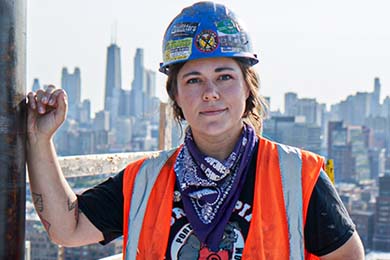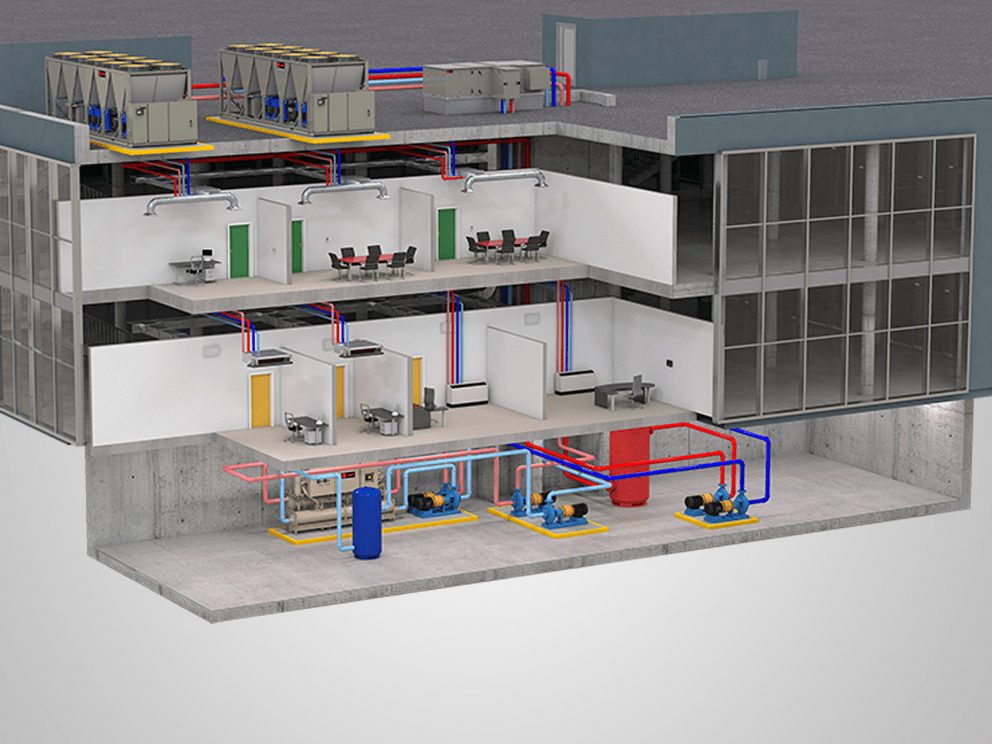Haley Whiting is an apprentice pipefitter in Chicago – Union Local 597. She’s been working in the trades for nearly five years and, in her early 30s, is one of the older apprentices. Her career started off in one direction before the construction industry finally found her.
I initially went to school for English and wanted to get into writing and the social sciences,” says Haley. “I wanted to do community-based organizing work. But I realized, in my late 20s, that to take my career to the next level, I either had to go back to school or completely switch gears. I chose construction. I wanted a career that felt meaningful to me, where I felt like I was creating a net positive.

The CWIT Connection
Haley did not get there on her own; she had a lot of support from Chicago Women in Trades (CWIT), a nonprofit organization that helps women get into trade unions: HVAC, pipefitters, electricians, ironworkers – the list is long.
“Chicago Woman in Trades is an awesome organization that really helped me along,” says Haley. “Their Technical Opportunities Program (TOP) gives women essential training to apply at trade unions and pass their entry tests. I had friends who went through CWIT, and they really encouraged me to check it out.”
TOP is a three-month construction boot camp that helps show women the bar they will have to reach to make it in the trades. There are weekly exercise routines to help build strength, as well as reading, math and logic tests. While CWIT is focused on helping women get into the trades, the organization wants to ensure they are the right women.
None of these tests were an issue for Haley. She had grown up in the country and was used to early mornings and physical exertion, which has given her a leg up in her work.
The TOP program emphasizes the basics, and attendance is just one example. “You have to show up for every class and you have to be on time,” says Haley. “If you're not, it’s pretty likely you will get kicked out of the program. They want people to understand what will be expected of them at their worksites.”
The Deadline
After completing TOP, Haley applied to local 597, which accepted her into an apprenticeship hybrid program. She had five months to learn to weld, become proficient and pass the United Association Welding Certificate test. Haley had never welded in her life.
“The program was five days a week,” says Haley. “The doors opened at six a.m. and closed at eight p.m., and they expected us to be there for at least 10 hours a day. At the end of five months, I’d take the test. If I passed it, I was in the union. If I failed, I would have been jobless, on my own.”
The test was quite rigorous, including both visual and X-ray inspections to catch any internal flaws. During the test, Haley spent hours on her assignment when she physically slipped.
“I was on the last part, right at the finish line, when I stumbled,” says Haley. “At first, I thought I blew it, but I was able to compose myself, fix the error and move on. And then it was the inspector’s turn. It was nail-biting, absolutely nail-biting.”
Women in the Trades
Now that she’s established herself in the trades, Haley likes to give back, volunteering at CWIT and sharing her experiences. She encourages women to get into the trades but does not sugarcoat it: They will have to prove themselves.
She tells them they will have to pick up heavy objects, and they should do everything they’re capable of doing.“I always tell women, do not let men work you out of a job,” says Haley. “You have to be willing to say no, I've got it. You have to hold yourself to a high standard because, if you don't, you can't know when you're actually encountering sexism, should you find yourself being treated differently. If you're not doing the job correctly, you will be told. The trades are a team effort and a process of learning.”

For Haley, the work is challenging, but it’s also quite rewarding. There are many opportunities to exercise brainpower, leadership and problem-solving, finding creative ways to make her work aesthetically pleasing. The job goes way beyond lifting big things and moving them – it’s skilled labor. Even the physical aspects are quite doable. She often tells her mentees: Don’t be intimidated.
“Women can do this work, it’s 2021,” says Haley. “We have equipment to help ease the load, and every year the technology gets better at reducing fatigue on the human body. That’s for everyone, women and men.”
Occasionally, Haley will see a social media post or some other message saying women should not be in construction – it’s just too dirty for them. She does not let that go.
“Women have been doing dirty hard work forever,” she says. “Country life isn't just men going out and doing that hard labor – men weren't the only ones plowing the fields. Women have been doing that work. And during the industrial revolution, women were in the cities, in those mills and factories. This idea of the 1950s housewife, that was a tiny moment in history.”
Doing the Job Right
Since joining local 597, Haley has been working for Premier Mechanical, which designs, installs and services HVAC systems. She takes tremendous pride in her work and often points out former construction sites to friends and family.
“I have every job site on my little Google® map,” she says. “My friends tease me that I'm like a dad. We’re driving around, and I'm like, yeah, I built that office. It’s a real source of pride.
Pipefitters at our company put a lot of care into making sure things are done right, installed and working correctly and there's an aesthetic quality to it.”
She feels there are many incorrect stereotypes about what a construction site is really like, and she tries to debunk them whenever she can. There’s great teamwork, and the pride is contagious. People work hard to keep their workspaces clean and organized. She works with a lot of technology that’s quite familiar to office workers: Zoom, Slack®, digital printing.
As an apprentice, she’s a bit removed from having day-to-day contact with vendors, yet she knows when she’s being supported.
“It's good to have confidence in the product you’re installing,” says Haley. “I know if it's Trane, I'm going to get good support, and there's a confidence that comes with that. I think there seems to be a really good line of communication and a sense of teamwork. It benefits both parties for things to run smoothly, for people to be happy, for things to be working well."
The Right Choice
In her fourth year as an apprentice, Haley is in a good place and is grateful for the life she has achieved and the journeymen and mentors who helped her get there.
“I went for it, and I owe a lot of my success to the network of women who said, ‘you got this,’” says Haley. “There’s a lot of solidarity that helped me through, and I always try to pay it forward.”
For Haley, it’s the complete package: pride in her work, regular hours, the ability to take a week off for vacation, save for retirement, buy a house – benefits every American worker should have.
And welding has become more than a job skill, as she’s using it for art and other fun side projects. She likes that she’s been able to pick up this amazing talent.
“I’m lucky to be in construction,” says Haley. “I feel satisfied by this process of physically building homes and workplaces and places for people to congregate. For me, that has tremendous value. It's also exciting to be doing something tangible, where at the end of the day, you can look back and see the real work you have accomplished.”
































































































